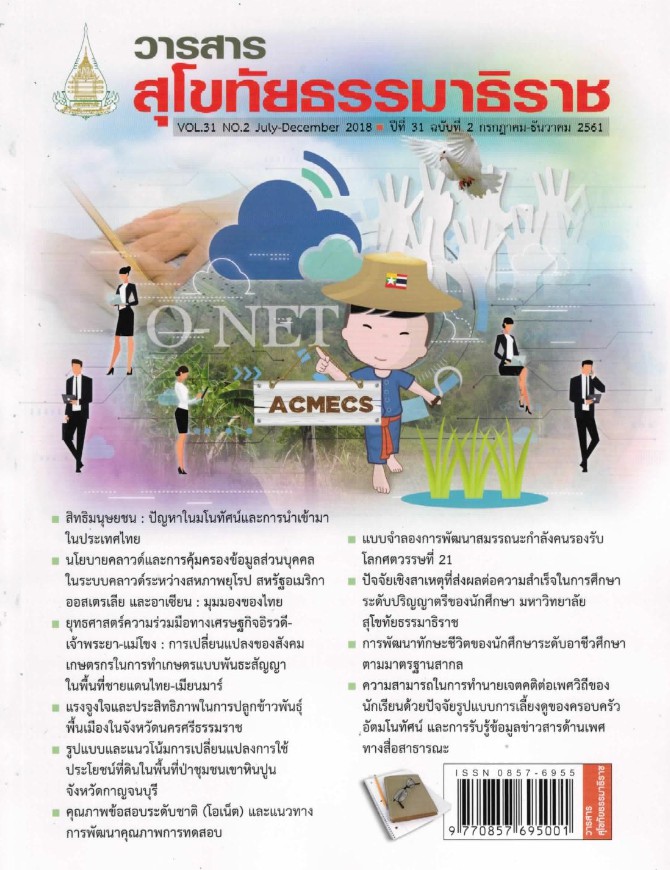รูปแบบและแนวโน้มการเปลี่ยนแปลง การใช้ประโยชน์ที่ดินในพื้นที่ป่าชุมชน เขาหินปูน จังหวัดกาญจนบุรี
คำสำคัญ:
ป่าชุมชนในเขตเขาหินปูน, การใช้ประโยชน์ที่ดิน, แนวโน้มการเปลี่ยนแปลงการใช้ประโยชน์ ที่ดินบทคัดย่อ
บทความวิจัยนี้มีวัตถุประสงค์เพื่อศึกษา 1) การกระจายตัวของป่าชุมชนที่อยู่ในเขตภูเขาหินปูน จังหวัด กาญจนบุรี 2) แนวโน้มการใช้ประโยชน์ที่ดินในพื้นที่ป่าชุมชนที่อยู่ในเขตภูเขาหินปูน จังหวัดกาญจนบุรี และ 3) เปรียบเทียบการเปลี่ยนแปลงการใช้ประโยชน์ที่ดินในป่าชุมชนเขาหินปูน จังหวัดกาญจนบุรี โดยใช้ กระบวนการศึกษาจากแนวคิดการสำรวจระยะไกลบนระบบภูมิสารสนเทศ ผลการศึกษาพบ 3 ประเด็นดังนี้ 1) การกระจายตัวของป่าชุมชนที่อยู่ในเขตภูเขาหินปูน จังหวัด กาญจนบุรี จากแปลงป่าชุมชนในจังหวัดกาญจนบุรี 93 แปลง กระจายอยู่ในเขตภูเขาหินปูน 10 แปลง 2) การใช้ประโยชน์ที่ดินในพื้นที่โดยรอบป่าชุมชนที่อยู่ในเขตภูเขาหินปูน จังหวัดกาญจนบุรีพบว่า กรณีศึกษา ทั้ง 3 แปลงมีแนวโน้มในการเปลี่ยนแปลงที่แตกต่างกัน โดยป่าชุมชนบ้านช่องแคบสามัคคีมีแนวโน้มการ เปลี่ยนแปลงที่จะปลูกพืชไร่เชิงพาณิชย์มากขึ้น แปลงป่าชุมชนสหกรณ์นิคมมีแนวโน้มที่จะมีการขยายตัวของการปลูกไม้ยืนต้นและไม้ผล และแปลงป่าชุมชนบ้านท่ากระดานมีแนวโน้มการใช้ประโยชน์ที่ดินในลักษณะ พื้นที่เบ็ดเตล็ดและพื้นที่เชิงพาณิชย์ และ 3) แนวโน้มการใช้ประโยชน์ที่ดินในพื้นที่ป่าชุมชนเขตภูเขาหินปูนมี การเปลี่ยนแปลงเล็กน้อยในป่าชุมชน เนื่องจากปัจจัยด้านเศรษฐกิจและการบริหารจัดการทรัพยากรป่าชุมชน
เอกสารอ้างอิง
Department of Mineral Resources. (2008). Area Classification for Geological and Mineral Resources Management. Bangkok: Advance Vision Service. (in Thai)
Ellis, F. (1998). “Survey Article: Household Strategies and Rural Livelihood Diversification”. Journal of Development Studies, 35(1), 1-38.
Forestry Research Center Faculty of Forestry Kasetsart University. (2017). Summary of Academic Forum: What is the Size of the Community Forest?. (online) source: http://frc.forest.ku.ac.th/seminar/downloads/20171123_100402.pdf (20 August 2017). (in Thai)
Geo-Informatics and Space Technology Development Agency. (2015). Space Technology and Geo-Informatics. Bangkok: Geo-Informatics & Space Technology Development Agency (Public Organization). (in Thai)
Goodman, D., & Michael, W. (1997). Globalising Food: Agrarian Questions and Global Restructuring (1st Ed.). New York: Routledge.
Manomaivibool, P., & et al. (2016). Summary Report on Forest Loss and Forest Restoration in Nan Province. School of Science, Mae Fah Luang University. (in Thai)
Nongnuch, T., Usavagovitwong, N., & Suttinun, P. (2015). Land Use Changes of Diversified Cultural Landscape: A Case Study of Nhong Bue Community, Chantaburi Province. The 10th Sripatum University National and international conferences. 22 December 2015,
pp. 696-703. (in Thai)
Sangawongse, S. (2000). Introduction to Remote Sensing and Remote Sensing Case Studies. Department of Geography, Faculty of Social Science, Chiangmai University. (in Thai)
Sawangdee, Y., Santiphop, T., & Katewongsa, P. (2011). “Environment, Demographic and Land Use Changein the Western and the Northeastern Region of Thailand : A Comparison Study between Kanchanaburi Project and Nang Rong Project”. Thailand’s Population
in Transition : A Turning Point for Thai Society. Nakhon Pathom. Institute of Population and Social research. Mahidol University. (in Thai)
The royal forest department. (2017). Community forest information. (online) source: http://forestinfo.forest.go.th/fCom.aspx?prov=71&zone=21&year=-1&eyear=-1&type=-1 (20 August 2017). (in Thai)
The royal forest department. (2017). Forests in Thailand. (online) source: http://forestinfo.forest.go.th/Content.aspx?id=80) (20 August 2017). (in Thai)
_________. (2017). Community Forest Type. (online) source: http://forestinfo.forest.go.th/55/fCom_area.aspx (20 August 2017). (in Thai)
_________. (2017). Community Forest Register. (online) source: http://forestinfo.forest.go.th/fCom.aspx?prov=71&zone=21&year=-1&eyear=-1&type=-1 (20 August 2017). (in Thai)
U.S. Department of the Interior U.S. Geological Survey. (2017). Satellite Database. Retrieved March 13, 2016, from http://Earthexplorer.usgs.gov.
ดาวน์โหลด
เผยแพร่แล้ว
รูปแบบการอ้างอิง
ฉบับ
ประเภทบทความ
สัญญาอนุญาต
บทความที่ได้รับการตีพิมพ์เป็นลิขสิทธิ์ของวารสารมหาวิทยาลัยสุโขทัยธรรมาธิราช
ข้อความที่ปรากฏในบทความแต่ละเรื่องในวารสารวิชาการเล่มนี้เป็นความคิดเห็นส่วนตัวของผู้เขียนแต่ละท่านไม่เกี่ยวข้องกับมหาวิทยาลัยสุโขทัยธรรมาธิราช และคณาจารย์ท่านอื่นๆในมหาวิทยาลัยฯ แต่อย่างใด ความรับผิดชอบองค์ประกอบทั้งหมดของบทความแต่ละเรื่องเป็นของผู้เขียนแต่ละท่าน หากมีความผิดพลาดใดๆ ผู้เขียนแต่ละท่านจะรับผิดชอบบทความของตนเองแต่ผู้เดียว
ห้ามนำข้อความทั้งหมด หรือบางส่วนไปพิมพ์ซ้ำ เว้นแต่จะได้รับอนุญาตจากกองบรรณาธิการวารสาร



